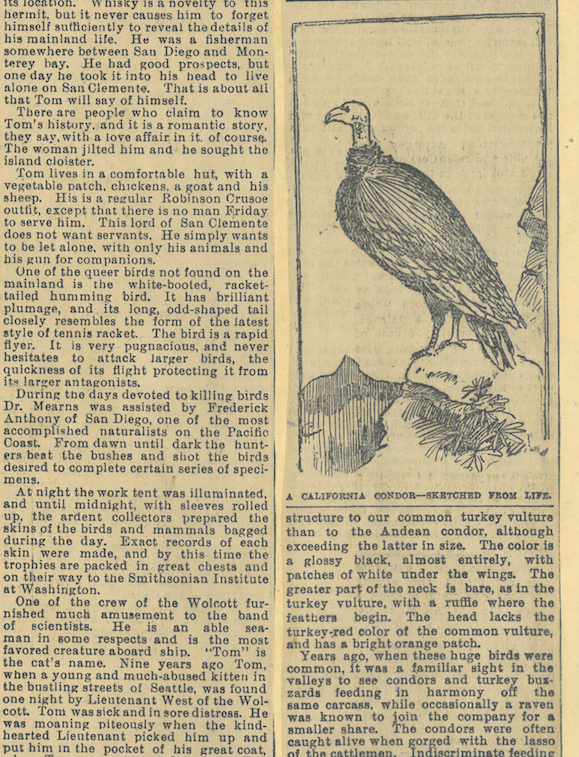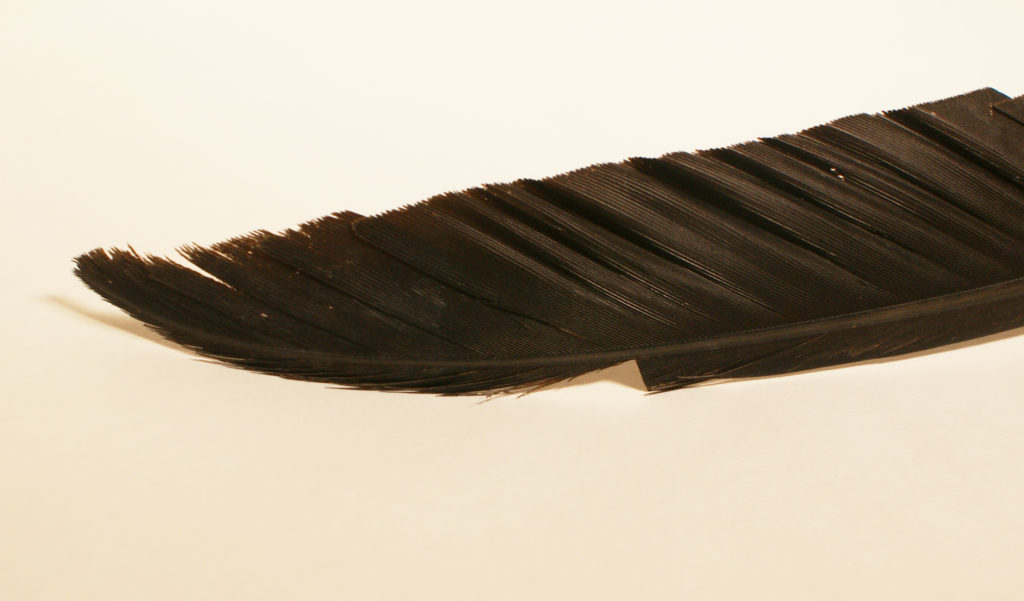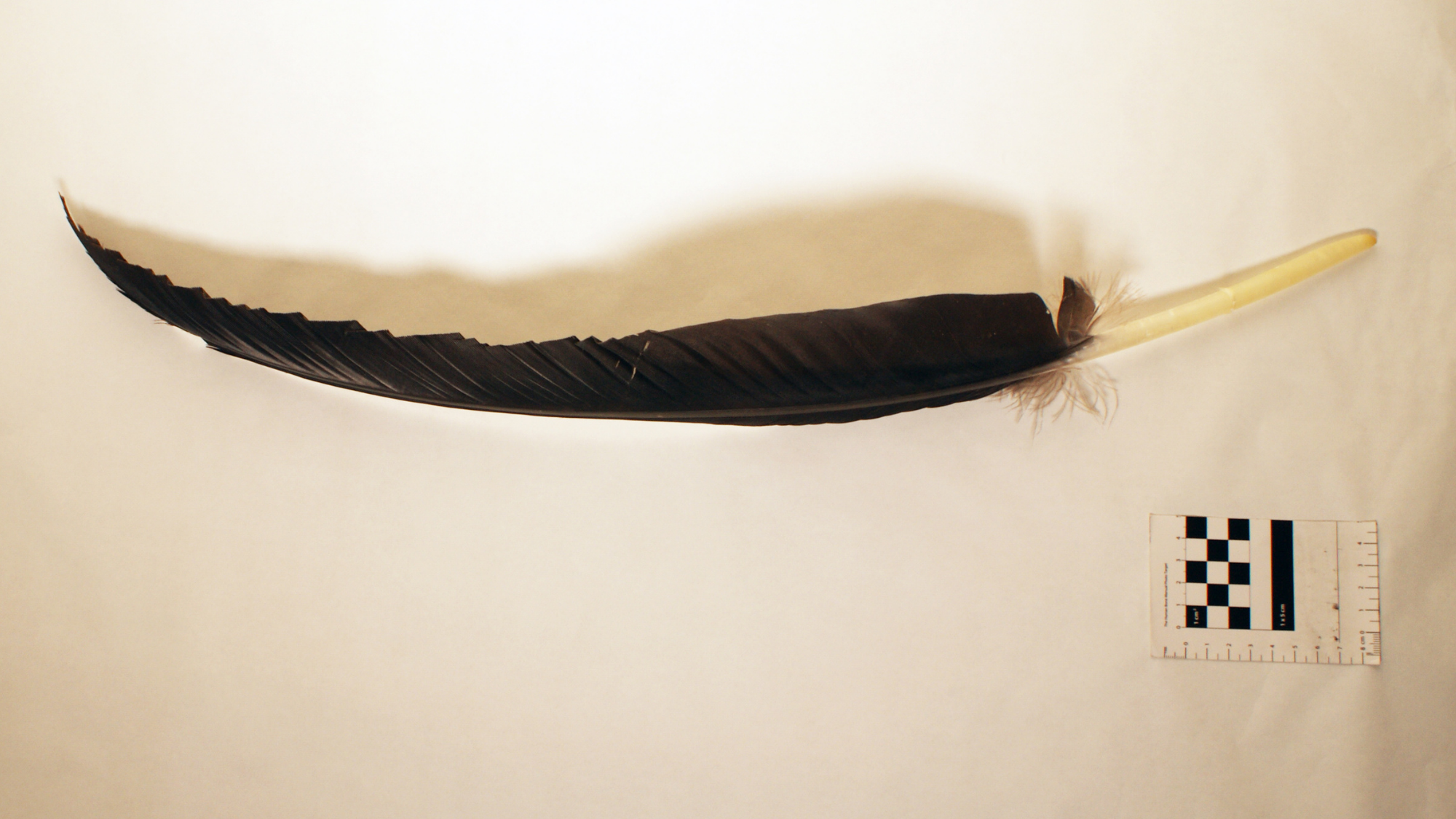Feathers are a marvel of evolution. They do a few different biological jobs: they insulate, waterproof and, of course, they make flight possible. But today, one especially large feather — the subject of this month’s close-up — will do more than fly. It will carry us into the world of California condor conservation and the birds’ returning path from the brink of extinction.
This dark feather, almost the size of a human arm, once belonged to a California condor. We’re not sure which exact bird it belonged to, but UC Santa Cruz environmental toxicologist Myra Finkelstein, who facilitated the gift of the feather to the Museum from the U.S. Fish and Wildlife Service and whose research has revealed a great deal about the birds’ plight, has narrowed it down to two animals. The first candidate, condor 222, is still flying over Central California today, where you might spot her identifying wing tags. The other, condor 306, is no longer soaring. On her last day in 2013, she flew into a power line while carrying ammunition pellets in her digestive tract and toxic levels of lead in her liver.
The fate of condor 306 is far from rare among these birds. While hunting condors has been illegal for nearly a century, their populations are still recovering from human activities that nearly exterminated the species. Exposure to poisons like lead ammunition (the leading cause of their mortality today) and DDT, and unintentional killing from predator control, among other pressures, forced populations into decline.

As far back as 1894, a newspaper clipping from Laura Hecox’s scrapbooks speaks of the birds’ low numbers: “Some day the nesting place of this great bird of the clouds may yet be found, but it must be soon, for ere long not a vestige of the doomed race will remain, save only on some lonely hill an ebon feather or bleaching bone.” Almost a century later in 1982, fewer than 30 of the animals survived worldwide.
What use does a feather have in helping to conserve a species so challenged? In the past, assessments of condor lead exposure were based largely on annual or biannual blood sampling. Lead tends not to stick around in blood for very long, however, so these samples only reveal so much. Feathers tell a different story.
Look closely at the close-up specimen — notice the small notch cut toward the top. Here, the delicate feather vanes extending from the hollow central shaft were trimmed when the feather was growing so biologists could go back and sample it when it was finished growing. Just as tree growth rings record past climatic conditions like dry and wet years, feathers reflect a condor’s history of lead exposure. Where blood samples reveal a few days worth of information, feathers can show months.

Biologists never remove whole feathers from condors. Instead, researchers gather them after they’re molted, or just cut the trailing edge of the feather vane. This feather is a primary remige or flight feather, meaning it generates much of the thrust needed for flight, helping to carry condors the roughly 100 miles they can travel each day while foraging for carrion.
Today, the California Condor Recovery Program leads the captive breeding and wild reintroduction program that, with great effort, has helped condors toward recovery. In 2017, 463 California condors were alive in release programs and captivity , with 170 of those individuals flying free outside of captive breeding programs across California — compare this to the mid 1980s, when the 22 remaining wild California condors were captured and placed in a captive breeding program to combat total extinction.
Wild release sites for the current southwestern population of condors already exist in Mexico and Arizona, and in California at Pinnacles National Monument, Ventana Wilderness and the Hopper Mountain National Wildlife Refuge Complex. A partnership facility between the Yurok Tribe of Northern California and federal agencies in Redwoods National Park is planning to release the first condors in Northern California skies as early as 2020 — an effort that designates the birds’ expansion into northern territories they were once common in.
Even sooner, Assembly Bill 711, which requires the use of non-lead ammunition when hunting wildlife with a firearm in California, is set to go into effect July 1, 2019. Studies show that, without eliminating or at least substantially reducing lead poisoning rates, the conservation of the California condor will continue to require intensive and ongoing management. In other words, lead poisoning stands in the way of a self-sustaining wild California condor population.
Dr. Finkelstein recommends http://huntingwithnonlead.org/ as a great resource for savvy hunters to help safeguard the health of condors and other wildlife. For other folks excited about helping condors, look to the citizen science project Condor Watch where you can help enhance project data by identifying individual birds. Finkelstein says this project is about to be overhauled, but to keep an eye out for its reboot over the next few months.
Please stop by this June and see this specimen for yourself! As a bonus for stopping by in person, you’ll be able to compare the notched feather to an un-notched specimen given to the Museum in the 1950s.

